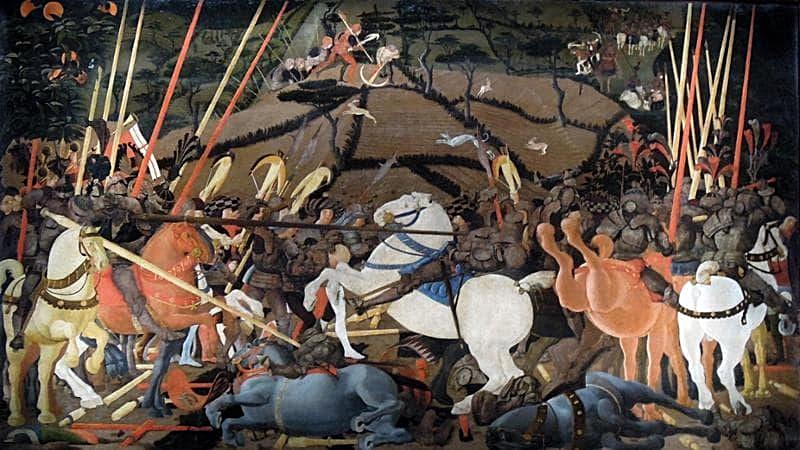
Paolo di Dono, renowned as Uccello, was an exceptionally versatile artist whose fascination with birds earned him his nickname. Uccello excelled in various artistic mediums, including tempera on wood, frescoes for churches, small devotional works, as well as mosaic and stained glass designs.
Many of his works, held in prestigious museums worldwide, can still be found in their original locations, such as the prominent Florence Cathedral and the cloister of Santa Maria Novella. Uccello received his training in Florence under the tutelage of the renowned sculptor Lorenzo Ghiberti, contributing to the magnificent bronze doors created by Ghiberti for the city’s baptistry. By 1415, Uccello established himself as an independent artist; however, details about his early career remain scarce. He spent several years in Venice before returning to Florence, where he predominantly worked for the remainder of his life.

In the collection of the National Gallery, one can find Uccello’s masterpiece titled “Niccolò Mauruzi da Tolentino at the Battle of San Romano.” The painting prominently features the Florentine commander, presented in a manner reminiscent of an equestrian monument. Riding a white horse that stands out amidst the darkened canvas, da Tolentino is adorned with a lavish velvet red and gold hat called a mazzocchio, which matches his cape. Notably, da Tolentino’s attire is not suitable for warfare; he wears a mail shirt but lacks a breastplate, and a page accompanies him, carrying his helmet. Brandishing a baton of command, the commander leads a cavalry charge depicted through overlapping layers.
While the intricate blend of crests, lances, and horses may make it challenging for viewers to discern a clear narrative, Uccello successfully captures the frenetic energy of the battle. However, the scene is not portrayed as a gory conflict but rather as a formal parade infused with pageantry. The doll-like appearance of humans and horses gives the artwork a tapestry-like quality. Uccello’s later works leaned towards more surreal and fairytale-inspired compositions, visible in pieces like “The Hunt in the Forest,” created between 1465 and 1470, which shares compositional similarities with “The Battle of San Romano” series.


The painting housed at the Uffizi Gallery, the sole piece that remains in Florence, is believed to depict Bernardino della Carda, the Sienese leader, being dismounted. The positioning of the weaponry suggests that the Florentine troops are advancing, while their rivals appear to retreat.

The Louvre’s panel, now displaying a ghost-like condition, portrays the counterattack by the Florentine ally, Michelotto da Cotignola. All the artworks of “The Battle of San Romano” were originally adorned with brilliant pigments, sparkling gold, and silver leaf. The visible signs of damage are the result of poorly executed cleanings and inherent changes in the materials used.
The armor that was once resplendent with ample metal leaf has since tarnished, while the banners and harnesses, originally painted vermilion, have now turned blue-grey. Details of the various elements and flesh tones have also faded over time. To gain insight into the artist’s original intent, one can examine Uccello’s “Saint George and the Dragon,” created around 1470, which is also part of the collection at the National Gallery.

The “Battle of San Romano” series was initially conceived to be placed high up on the walls of a room under a vaulted ceiling. To fit around the corbels, the original panels had irregularly shaped corners and arched tops. When they were relocated from the Bartolini Salimbeni home, they underwent alterations and were reshaped into rectangles to suit the architectural requirements of their new location. This explains the current tightly cropped compositions seen in the artworks.
Uccello, a prominent figure in the development of Florentine Renaissance painting during the quattrocento period, created the striking “Battle of San Romano” series, which stands as a testament to his mastery of perspective.
Discover more from Tension News
Subscribe to get the latest posts sent to your email.

